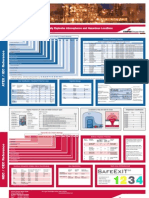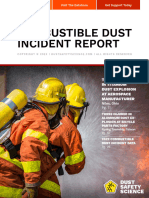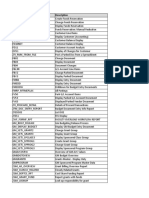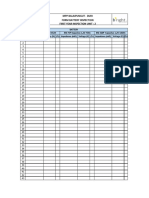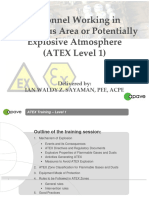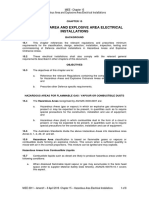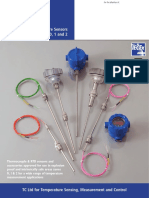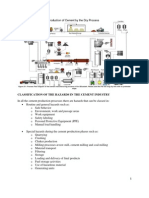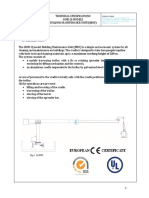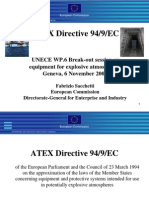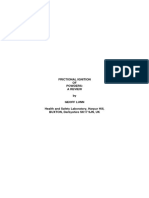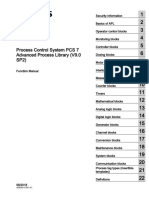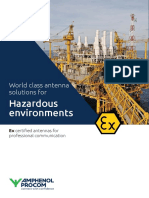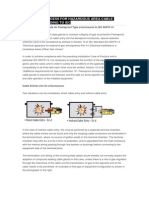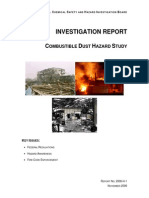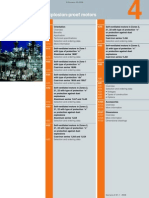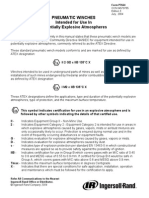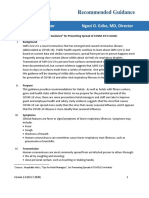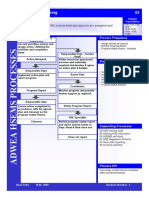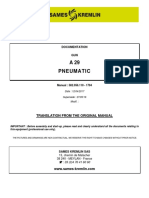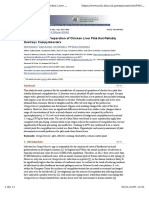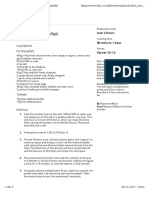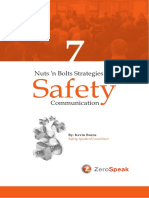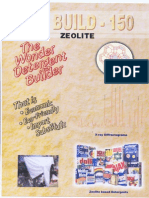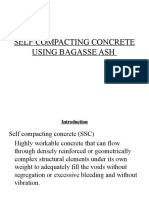Checklist For Explosion-Proof Gearmotor
Checklist For Explosion-Proof Gearmotor
Uploaded by
marius_brkt6284Copyright:
Available Formats
Checklist For Explosion-Proof Gearmotor
Checklist For Explosion-Proof Gearmotor
Uploaded by
marius_brkt6284Original Title
Copyright
Available Formats
Share this document
Did you find this document useful?
Is this content inappropriate?
Copyright:
Available Formats
Checklist For Explosion-Proof Gearmotor
Checklist For Explosion-Proof Gearmotor
Uploaded by
marius_brkt6284Copyright:
Available Formats
Drive Technology \ Drive Automation \ System Integration \ Services
ATEX, IECEx
Inquiry Form and Checklist for Explosion-Proof Gearmotors
Edition 10/2012
19498810 / EN
SEW-EURODRIVEDriving the world
Inquiry form and checklist for explosion-proof gearmotors
Explosion-protection designation
Inquiry form and checklist for explosion-proof gearmotors
Inquiry form and Checklist
The following inquiry form and checklist will help you to determine the necessary information for specifying the unit properties and unit categories of gearmotors that are used
in potentially explosive atmospheres.
Observe the possible options within the individual categories or EPL.
1.1
Explosion-protection designation
The following tables are to provide an overview of the used explosion-protection designation.
Equipment groups:
Equipment
group
Description
Equipment for use in mine openings with a risk of firedamp (underground mining)
II
Equipment for use in areas with potentially explosive gas/air mixtures
III
Equipment for use in areas with potentially explosive dust/air mixtures
In addition, the new equipment group III has been split up into three subgroups "A", "B"
and "C" depending on the type of dust. The following table shows this division.
Equipment
group
Suitable for atmospheres with
Required minimum IP rating
IIIA
Inflammable fluffing
IP5x
IIIB
Non-conducting dust
IP5x
IIIC
Conducting dust
IP6x
Zone division:
Zone
Probability of a potentially explosive atmosphere occurring
Gas
Dust
21
Occasional, in normal operation
22
Seldom, short-term
Protection types
Unit type
Motors (electrical
units)
Gear units
(mechanical units)
ATEX and IECEx Inquiry form and Checklist
Protection
type
Standard
Description:
EN 60079-0 and -1
Flameproof enclosure
EN 60079-0 and -7
Increased safety
n / nA
EN 60079-0 and -15
Non-sparking
EN 60079-0 and -31
Dust explosion protection
EN 13463-1 and -5
Constructional safety
EN 13463-1 and -8
Liquid immersion
Inquiry form and checklist for explosion-proof gearmotors
Inquiry form for explosion-proof gearmotors
1
1.2
Inquiry form for explosion-proof gearmotors
Customer data
Company
Customer no.:
Department:
Phone number:
Name:
Fax number:
Street/P.O. box:
Email:
Zip code/city:
Technical data
Catalog designation:
Quantity
Desired delivery date:
Gear unit type/motor data
Helical gear unit
Parallel-shaft helical
gear unit
Power:
Helical worm gear unit SPIROPLAN
Helical-bevel gear
unit
kW Output speed:
rpm Output torque:
1-shift operation
2-shift operation
3-shift operation
Regular
Mounting position
M1
M3
M5
M2
Housing Foot mounting
Shaft type
M4
Flange (bore)
Nm Cycles/hour:
Irregular
M6
c/h
Very irregular
Pivot
Flange (thread)
Torque arm
Misc
Solid shaft with key
Shrink disk
Shaft-/hollow shaft :
mm
Solid shaft with key
TorqLOC
Flange:
mm
Shaft position (right-angle
gear unit)
Terminal box position
0 (R)
Cable entry
IP56
Degree of protection
IP54
130 (B)
Surface protection
OS1
Corrosion protection
OS4
Supply voltage:
180 (L)
270 (T)
IP65
155 (F)
OS2
OS3
Line frequency:
Connection type:
AB
90 (B)
Thermal class
Inverter operation
Double gear unit
OS4
50 Hz
60 Hz
Required max. speed:
Max. frequency:
Hz
rpm
Setting range:
Inquiry regarding the typical application (when using the drive in potentially explosive atmospheres)
Typical application
Supply voltage:
Installation:
Deviations from the typical application:
400 V 5 %
Without line filter, choke, without sine filter
MOVITRAC B, MOVIDRIVE B
Frequency inverter:
Motor cable/permitted:
100 m / max. 10 V
Rated motor voltage:
230 V / 400 V, 50 Hz
Required options
Brake
Brake voltage:
Manual brake release
HR
Motor protection
RAL7031
TF Encoder
RAL
Braking torque:
Nm
HF Forced cooling fan Forced cooling fan
voltage:
Inverter
Further options:
Special ambient conditions
Temperature from
Installation altitude >
1000m
to
C Operation outdoors
m
Other specifics:
Misc:
ATEX and IECEx Inquiry form and Checklist
Inquiry form and checklist for explosion-proof gearmotors
Checklist for explosion-proof gearmotors according to ATEX and IECEx
1.3
Checklist for explosion-proof gearmotors according to ATEX and IECEx
Step
Criterion
Underlying standards
Potentially explosive mixture of air and
Condition
Decision
Continue
with step
ATEX
IECEx
Gas
Dust
Zone 1
For gas
3
4
5
Drive will be installed in
Zone 2 (nA)
In the case of zone 1, the protection type of the motor is prescribed by the customer as
Flameproof enclosure (d)
Increased safety (e)
In the case of motors with flameproof enclosure, design of the
terminal box (TB)
TB with flameproof enclosure (d)
TB with increased safety (e)
IIA
6
Group specification
IIB
IIC
T3
7
Temperature class (for gas/air mixtures)
T4
T5 (only with flameproof enclosure)
10
T6 (only with flameproof enclosure)
For dust
site of operation zone 21
Protection type tb
8
site of operation zone 22
Protection type tc
IIIA (flammable lint)
IIIB (non-conducting dust)
IIIC (conducting dust)
IIIA (flammable lint)
IIIB (non-conducting dust)
IIIC (conducting dust)
T120 C
Maximum permitted surface temperature (for dust/air mixtures)
T140 C
10
T150 C (only for synchronous
servo gearmotors)
Operating mode
Line operation S1
10
Line operation S1, S4 50% only category 2 / EPL b
Inverter operation VFC
Inverter operation CFC only category 3 / EPL c
ATEX and IECEx Inquiry form and Checklist
Inquiry form and checklist for explosion-proof gearmotors
Checklist for explosion-proof gearmotors according to ATEX and IECEx
Notes on the individual items:
Step 1
Standard reference ATEX: Directive 1999/92/EG with EN 60079 as well as other local
plant- and country-specific regulations.
Standard reference IECEx: IEC 60079 as well as other local plant- and country-specific
regulations.
Zone categorization according to the installation location of the drive. The operator is responsible for the zone categorization.
Assistance is available in
IEC/EN 60079-10 for gas
IEC/EN 60079-10-2 for dust (replaces IEC 61241-10) as well as expert offices, in
Germany also (German Technical Control Board), German Institutions for Statutory
Accident Insurance and Prevention.
Step 2
Categorization of the potentially explosive atmosphere into gas or dust.
Step 3
The standard reference must be checked, ATEX or IECEx as well as other local plantand country-specific regulations.
Zone categorization according to the installation location of the drive. The operator is responsible for the zone categorization.
Zone 1: Potentially explosive gas mixtures are to be expected in normal operation.
Zone 2: Potentially explosive gas mixtures are not to be expected in normal operation
and if they occur at all, then only briefly.
Step 4
Protection types of the motor for use in zone 1.
Flameproof enclosure (d)
Potentially explosive mixtures can penetrate the equipment, the mixture inside the
housing can be ignited Design measures prevent ignition of the external atmosphere
Increased safety (e)
Potentially explosive mixtures can penetrate the equipment, no sources of combustion in or on the equipment No ignition of the gas mixture.
ATEX and IECEx Inquiry form and Checklist
Inquiry form and checklist for explosion-proof gearmotors
Checklist for explosion-proof gearmotors according to ATEX and IECEx
Step 5
Design of the terminal box in the case of motors with flameproof enclosure with protection type
Flameproof enclosure (d)
When this terminal box version is selected, it is essential to take account of the permitted cable bushings (conduit system, cable glands, etc.). In addition, the thread
type of the screw fitting (ISO or NPT) must be specified.
Increased safety (e)
When this terminal box version is selected, the cable entry design can be simpler. It
is merely necessary to use an Ex-certified screw fitting.
Step 6
Group II is divided into 3 subgroups according to substance.
All protection types
Electrostatic requirements for plastic surfaces (including paint). As a consequence,
the EX designation of protection types "e" and "nA" (previously II) is changed to IIA,
IIB or IIC, depending on the plastic surfaces or paint used.
Additionally for flameproof enclosure (d)
Here, the subgroup determines the parameters of the ignition gap.
Also observe the country-specific literature:
Germany: Nabert/Schn, "Kennzahlen brennbarer Gase und Dmpfe" ("Classifications of flammable gases and vapors"), Deutscher Eichverlag GmbH, D-38102
Braunschweig, Germany
Step 7
Each of the temperature classes represents the assured maximum surface temperatures of the drive. For information about the temperature classes of the hazardous materials, refer to step 5:
T3: Max. permitted surface temperature: 200 C
T4: Max. permitted surface temperature: 135 C
T5: Max. permitted surface temperature: 100 C
T6: Max. permitted surface temperature:
ATEX and IECEx Inquiry form and Checklist
85 C
Inquiry form and checklist for explosion-proof gearmotors
Checklist for explosion-proof gearmotors according to ATEX and IECEx
Step 8
The standard reference must be checked, ATEX or IECEx as well as other local plantand country-specific regulations.
Zone categorization according to the installation location of the drive. The operator is responsible for the zone categorization.
Zone 21: Potentially explosive dust/air mixtures are to be expected in normal operation.
Zone 22: Potentially explosive dust/air mixtures are not to be expected in normal operation and if they occur at all, then only briefly.
Group III is divided into 3 subgroups according to substance.
tb
Zone 21
tc
Zone 22
Group
Suitable for atmospheres with
IIIA
Inflammable fluffing
5x
5x
IIIB
Non-conducting dust
6x (65)
5x (54)
IIIC
Conducting dust
6x (65)
6x (65)
Minimum degree of protection IP
Values in brackets: SEW standard
Step 9
The maximum surface temperature of a drive in dust/air mixtures. The value is specified
in C. The maximum surface temperature of synchronous servo gearmotors is 150 C.
Also observe further country-specific information:
Germany: BIA-Report "Brenn- und Explosionskenngren von Stuben" (Report no.
3051 of BG Institute for Occupational Safety, "Combustion and explosion characteristics of dusts"), Hauptverband der gewerbl. Berufsgenossenschaften, D-53757 St.
Augustin, Germany
Step 10
The operating modes differ as follows:
1. Line operation
S1 mode: Continuous duty, unlimited operation with constant load permitted
S1, S4-50% mode (only ATEX in category 2): Continuous duty, unlimited operation with constant load permitted; in intermittent duty, the start-up affects the temperature
2. Inverter operation
VFC mode
CFC mode only with encoder for zone 2 and 22 in category 3
ATEX and IECEx Inquiry form and Checklist
SEW-EURODRIVEDriving the world
SEW-EURODRIVE
Driving the world
SEW-EURODRIVE GmbH & Co KG
P.O. Box 3023
D-76642 Bruchsal/Germany
Phone +49 7251 75-0
Fax +49 7251 75-1970
sew@sew-eurodrive.com
www.sew-eurodrive.com
You might also like
- Hazardous Area Table IEC & NEC (NEMA) Cooper Crouse Hinds PDFDocument1 pageHazardous Area Table IEC & NEC (NEMA) Cooper Crouse Hinds PDFAgustinus Made Theo Dwijaya100% (4)
- 2023 Original MSPD1 2023Document13 pages2023 Original MSPD1 2023Arnel GalloNo ratings yet
- Technical Data: GHG 618 Installation Contactor 20 A Up To 32 ADocument4 pagesTechnical Data: GHG 618 Installation Contactor 20 A Up To 32 Akhairalla mohamedNo ratings yet
- Vahid Ebadat Presentation Static Hazards Istanbul 10-24-2015 01Document39 pagesVahid Ebadat Presentation Static Hazards Istanbul 10-24-2015 01Ekopribadi100% (1)
- Explosive Atmospheres Brochure 3AUA0000037223 REVC en LowresDocument24 pagesExplosive Atmospheres Brochure 3AUA0000037223 REVC en Lowresckwei0910No ratings yet
- MAXON PresentationDocument27 pagesMAXON PresentationJaroslav KurucNo ratings yet
- Atex ExplainedDocument3 pagesAtex ExplainedErica LindseyNo ratings yet
- CMP IECEx ATEX 01Document10 pagesCMP IECEx ATEX 01rocket-vtNo ratings yet
- HSE Control Systems For ESDDocument9 pagesHSE Control Systems For ESDFreddy TanNo ratings yet
- 2022 Combustible Dust Incident Report Version 1Document43 pages2022 Combustible Dust Incident Report Version 1Igor MeloNo ratings yet
- List of SAP T-CodesDocument18 pagesList of SAP T-CodesastinetNo ratings yet
- Form Battery InspectionDocument2 pagesForm Battery InspectionRaharja DebianNo ratings yet
- Report Dust Explosion Protection Using Flameless VentingDocument18 pagesReport Dust Explosion Protection Using Flameless Venting설동하No ratings yet
- Explosion Protection Theory and Practice - Phoenix ContactDocument40 pagesExplosion Protection Theory and Practice - Phoenix Contactcuongphan123No ratings yet
- Fm-Ul AtexDocument1 pageFm-Ul AtexPrem KumarNo ratings yet
- Atex MotorDocument28 pagesAtex MotorKhaled HassanNo ratings yet
- Ficha Tecnica y Certificado de Bituminoso MartinDocument2 pagesFicha Tecnica y Certificado de Bituminoso MartinPasion Argentina EliuNo ratings yet
- Iec 60489-8Document59 pagesIec 60489-8waqas ahmed awanNo ratings yet
- ATEX Training - Level 1Document244 pagesATEX Training - Level 1Naveed RehmanNo ratings yet
- 15 - Hazardous AreasDocument8 pages15 - Hazardous AreasDave CNo ratings yet
- ATEX Presentation To CustomersDocument28 pagesATEX Presentation To CustomersSameh EzzatNo ratings yet
- UK ATEX IECEx Sensor CatalogueDocument26 pagesUK ATEX IECEx Sensor Cataloguedj22500No ratings yet
- Explosion-Proof KnowledgeDocument4 pagesExplosion-Proof KnowledgeEra SutrajayaNo ratings yet
- ATEXDocument12 pagesATEXJacqueline AdamsNo ratings yet
- Europump Atex Guide - I-Rev2019 1.0Document25 pagesEuropump Atex Guide - I-Rev2019 1.0Antonio MakkarovNo ratings yet
- Basic Concepts For Explosion ProtectionDocument52 pagesBasic Concepts For Explosion ProtectionReinaldo SouzaNo ratings yet
- Risk Analysis ATEXDocument14 pagesRisk Analysis ATEXbaaziz2015No ratings yet
- ATEX PosterDocument1 pageATEX PosterJuan Ramon RodriguezNo ratings yet
- IECEx OD504 Ed3.0Document67 pagesIECEx OD504 Ed3.0Bhavesh AroraNo ratings yet
- Classification of The Hazards in The Cement IndustryDocument12 pagesClassification of The Hazards in The Cement IndustryUtari Nuravifah100% (2)
- NHP - Hazardous Area GuideDocument8 pagesNHP - Hazardous Area GuideMidhunNo ratings yet
- Atex ClassificationDocument1 pageAtex ClassificationDANE80No ratings yet
- Open Loop Vs Sensor Less Flux Vector ControlDocument3 pagesOpen Loop Vs Sensor Less Flux Vector ControlDavor JunušićNo ratings yet
- ATEX Advisory - Simple ApparatusDocument2 pagesATEX Advisory - Simple ApparatusPeter AllisonNo ratings yet
- 3 Wood HandlingDocument15 pages3 Wood HandlingMostafa MehrjerdiNo ratings yet
- Gas Detection Bump Test and Calibration FrequencyDocument2 pagesGas Detection Bump Test and Calibration FrequencywertyyyNo ratings yet
- DS59 IEC 60079 0 2011 The Differences and The ConsequencesDocument3 pagesDS59 IEC 60079 0 2011 The Differences and The ConsequencesGlen AshwellNo ratings yet
- GinD SJ Machine General SpecificationsDocument6 pagesGinD SJ Machine General SpecificationsUchennaNo ratings yet
- 1 Sira 04ATEX1357U.iss 6Document6 pages1 Sira 04ATEX1357U.iss 6Juan Vargas FerrerNo ratings yet
- Explosion Proof MotorsDocument21 pagesExplosion Proof MotorsJan AbuYildirimNo ratings yet
- ZonesDocument19 pagesZonesVaidheeshwar VetrivelNo ratings yet
- Clasificacion AtexDocument1 pageClasificacion AtexluciaNo ratings yet
- Guia General Linear Heat Detection Application GuideDocument74 pagesGuia General Linear Heat Detection Application GuideMaríaPaula CheheidNo ratings yet
- Frictional Ignition OF Powders: A Review by Geoff Lunn Health and Safety Laboratory, Harpur Hill, BUXTON, Derbyshire SK17 9JN, UKDocument34 pagesFrictional Ignition OF Powders: A Review by Geoff Lunn Health and Safety Laboratory, Harpur Hill, BUXTON, Derbyshire SK17 9JN, UKsagarraNo ratings yet
- 3 TUTORIAL 3 Hazard IdentificationDocument3 pages3 TUTORIAL 3 Hazard IdentificationAnonymous T7vjZG4otNo ratings yet
- AREA CLASSIFICATION For Landfill Gas Extraction Utilisation and CombuctionDocument39 pagesAREA CLASSIFICATION For Landfill Gas Extraction Utilisation and Combuctionanac_mathNo ratings yet
- Advanced Process Library (V9.0)Document2,524 pagesAdvanced Process Library (V9.0)DavidNo ratings yet
- NMMC DCR SummaryDocument33 pagesNMMC DCR SummaryRoyal JadhavNo ratings yet
- AtexDocument8 pagesAtexBao Quoc Mai100% (1)
- Buchholz RelayDocument9 pagesBuchholz RelayExa AkbarNo ratings yet
- 330.ICM1500 Instrument Seals, Purges, and WinterizingDocument71 pages330.ICM1500 Instrument Seals, Purges, and WinterizingTpNo ratings yet
- Rectangular Explosion Vent EDPDocument24 pagesRectangular Explosion Vent EDPkeduseNo ratings yet
- Fy15 sh-27664-sh5 Confined Space PPT 0Document119 pagesFy15 sh-27664-sh5 Confined Space PPT 0Zé MiNo ratings yet
- Selection Process For Hazardous Area Cable Glands According To IecDocument5 pagesSelection Process For Hazardous Area Cable Glands According To Iecaugur886No ratings yet
- CSB Dust Study Report 6-20-08Document119 pagesCSB Dust Study Report 6-20-08ddorinellNo ratings yet
- IECEX ATEX ComparisonDocument6 pagesIECEX ATEX ComparisonPilsner80No ratings yet
- CompEx Summary of KeypointsDocument30 pagesCompEx Summary of KeypointsBala KadirNo ratings yet
- Explosion Proof Motor CatalogDocument152 pagesExplosion Proof Motor CatalogBudy AndikaNo ratings yet
- 2010 Catalogo Americano CompletoDocument1,474 pages2010 Catalogo Americano CompletoisidriskyNo ratings yet
- Air-Winch Manual PDFDocument56 pagesAir-Winch Manual PDFQuyet Nguyen0% (1)
- 5.7 Hazop V1.0Document25 pages5.7 Hazop V1.0marius_brkt6284No ratings yet
- Hotel Guidance With Fitness Centers GymDocument4 pagesHotel Guidance With Fitness Centers Gymmarius_brkt6284No ratings yet
- 911v Activator 911 Msds EuDocument9 pages911v Activator 911 Msds Eumarius_brkt6284No ratings yet
- Hse ProcedureDocument47 pagesHse Proceduremarius_brkt6284No ratings yet
- Dclunica An2019 06062019 PDFDocument1 pageDclunica An2019 06062019 PDFmarius_brkt6284No ratings yet
- Risk Assessment of Explosive Atmospheres in WorkplDocument10 pagesRisk Assessment of Explosive Atmospheres in Workplmarius_brkt6284No ratings yet
- Overview of Consequence Modelling in The Hazard As PDFDocument9 pagesOverview of Consequence Modelling in The Hazard As PDFmarius_brkt6284No ratings yet
- Poster ATExDocument1 pagePoster ATExmarius_brkt6284No ratings yet
- Automatic Spray Gun AGR-08Document1 pageAutomatic Spray Gun AGR-08marius_brkt6284No ratings yet
- 2012 Catalogus 3 AirmixDocument70 pages2012 Catalogus 3 Airmixmarius_brkt6284No ratings yet
- Eurolux R - enDocument1 pageEurolux R - enmarius_brkt6284No ratings yet
- Catalog Leon 06 04 2017Document20 pagesCatalog Leon 06 04 2017marius_brkt6284No ratings yet
- Datasheet P 250ib 15Document1 pageDatasheet P 250ib 15marius_brkt6284No ratings yet
- ExSchutzkatalog Englisch 1Document61 pagesExSchutzkatalog Englisch 1marius_brkt6284No ratings yet
- A29 Instructions Manual Sames Kremlin 582056110 UkDocument35 pagesA29 Instructions Manual Sames Kremlin 582056110 Ukmarius_brkt6284No ratings yet
- 08explosion Protected Electric Motors PDFDocument5 pages08explosion Protected Electric Motors PDFmarius_brkt6284No ratings yet
- Safe Liver ParfaitDocument11 pagesSafe Liver Parfaitmarius_brkt6284No ratings yet
- Anexa 1 Iso 17776Document10 pagesAnexa 1 Iso 17776marius_brkt6284No ratings yet
- Chicken Liver Parfait Raymond BlancDocument3 pagesChicken Liver Parfait Raymond Blancmarius_brkt6284No ratings yet
- Pegasus FerroliDocument6 pagesPegasus Ferrolimarius_brkt6284No ratings yet
- Bit DefenderDocument130 pagesBit Defendermarius_brkt6284No ratings yet
- 7 Strategies For Safety CommDocument31 pages7 Strategies For Safety Commmarius_brkt6284No ratings yet
- BOOK Evidence Based Outcome Research A Practical Guide To Conducting Randomized Controlled Trials For Psychosocial Interventions PDFDocument513 pagesBOOK Evidence Based Outcome Research A Practical Guide To Conducting Randomized Controlled Trials For Psychosocial Interventions PDFRubí Corona TápiaNo ratings yet
- T Enclosure Series Spec (98909) D.2-1595820Document2 pagesT Enclosure Series Spec (98909) D.2-1595820Dadang IbnuNo ratings yet
- Lynn Margulis: Essay by James LovelockDocument5 pagesLynn Margulis: Essay by James LovelockChelsea Green Publishing100% (4)
- Places in A City VocabularyDocument4 pagesPlaces in A City Vocabularyanon_691288339No ratings yet
- Zeolite 4A White Powder For Detergent Det Build 150Document2 pagesZeolite 4A White Powder For Detergent Det Build 150kanu Patel100% (1)
- Computers in Human Behavior: Karina Caro, Ana I. Martinez-Garcia, Mónica Tentori, Ivan Zavala-IbarraDocument19 pagesComputers in Human Behavior: Karina Caro, Ana I. Martinez-Garcia, Mónica Tentori, Ivan Zavala-IbarraarthurqazwerNo ratings yet
- Janusz S Laskowski PDFDocument178 pagesJanusz S Laskowski PDFjoseph ayronNo ratings yet
- Auth Cand CTETDocument2 pagesAuth Cand CTETBalaji YNo ratings yet
- Home Following Answer Spaces Notifications: Add QuestionDocument26 pagesHome Following Answer Spaces Notifications: Add QuestionDeepak SehgalNo ratings yet
- WinterWonderlandCurriculum Preschool KinderDocument12 pagesWinterWonderlandCurriculum Preschool KinderIreneIrene100% (2)
- Self Compacting Concrete Using Bagasse AshDocument17 pagesSelf Compacting Concrete Using Bagasse AshSumit Sulibhavi 2BA18CV434No ratings yet
- According To The StudyDocument11 pagesAccording To The StudyDavid Samson ChanNo ratings yet
- Week No. 3 Construction and Operating Principles of The Different Types of Gas TurbineDocument2 pagesWeek No. 3 Construction and Operating Principles of The Different Types of Gas TurbineBeah monique FaustinoNo ratings yet
- Governance - 01 - Task - Performance - 1Document2 pagesGovernance - 01 - Task - Performance - 1Catherine LaguitaoNo ratings yet
- BX2051 - Assessment One InformationDocument4 pagesBX2051 - Assessment One InformationVais VaishnavNo ratings yet
- NCP1607 Cost Effective Power Factor Controller: Marking DiagramsDocument23 pagesNCP1607 Cost Effective Power Factor Controller: Marking DiagramslewisneoNo ratings yet
- Theun MUTEMagazineDocument72 pagesTheun MUTEMagazinePulak BagariaNo ratings yet
- Exact Calculation of Corrosion Rates by The Weight Loss MethodDocument12 pagesExact Calculation of Corrosion Rates by The Weight Loss Method드라코너스1No ratings yet
- Mechanical Properties of Aluminium AlloysDocument2 pagesMechanical Properties of Aluminium AlloysHytech Pvt. Ltd.No ratings yet
- Annual Report Page-3Document1 pageAnnual Report Page-3Amin RizkyNo ratings yet
- LifeCare DeraDocument13 pagesLifeCare Derasandeep singh cheemaNo ratings yet
- Cutting FluidDocument8 pagesCutting FluidDevarakonda KondayyaNo ratings yet
- LOIVDocument8 pagesLOIVSudev SinghNo ratings yet
- 2 R100004897E - PML145 (S Series) Traction Machine Installation and Maintenance Manual - ADocument32 pages2 R100004897E - PML145 (S Series) Traction Machine Installation and Maintenance Manual - AStefan HoNo ratings yet
- Unit 6 Components of A Balanced DietDocument8 pagesUnit 6 Components of A Balanced DietAKHLAQ FATIMANo ratings yet
- Pse - 1Document9 pagesPse - 1Phước Nguyễn Hữu83% (6)
- Masturbation Brad Bigney OverviewDocument3 pagesMasturbation Brad Bigney OverviewJohn Fieck100% (1)
- STPM Physics Chapter 13 Capacitors PDFDocument1 pageSTPM Physics Chapter 13 Capacitors PDFChris LauNo ratings yet
- June 2016 Aventus Clinic Operations Services (1) - 1Document21 pagesJune 2016 Aventus Clinic Operations Services (1) - 1xxcarxxNo ratings yet

